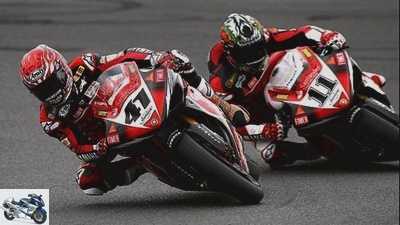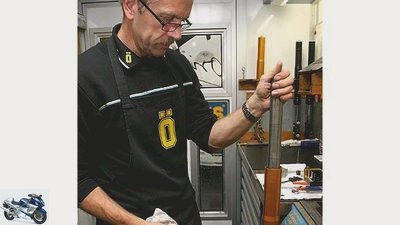Table of contents
- Superbike World Championship technology Ohlins chassis electronics
- Ohlins chassis electronics
- Pandora’s Box?

2Snap
accesories
landing gear & Spring elements
Superbike World Championship technology
Superbike World Championship technology
Ohlins chassis electronics
Content of
The new, electronically controlled chassis from the Swedish specialist manufacturer Ohlins contributed significantly to the soaring of the two factory Yamaha in the second half of the season of the Superbike World Championship. But the rulers of the racing series suspect disaster and want to ban the electronic setup aids again.
Michael Rohrer
December 18, 2008
Ohlins chassis electronics
Martin Lugnberg and Anders Andersson no longer really know whether they should be proud of their latest stroke of genius: the development engineer and race service manager from Ohlins have a lot of work to do in a new development with the inconspicuous name “Ohlins EC” which could revolutionize the chassis technology of racing and production motorcycles. “With our new system, we can make the coordination of fork and shock absorber variable”, explains Lugnberg. “More precisely: We can program the setup so that it changes its setting up to 20 times per lap. This means that the almost perfectly coordinated chassis is available to the driver in almost all situations.”
Lugnberg does not want to reveal the exact functioning of the system, which is based on the well-known Ohlins suspension components TTXL. In the hump of Noriyuki Hagas and Troy Corser’s factory Yamahas, however, the chassis control unit is located directly next to the control unit of the 2D data recording system. So one can speculate whether, for example, the chassis electronics will be fed with GPS data. Ohlins used the new system for the first time at the appearance of the Superbike World Championship at Miller Motorsports Park / USA in the middle of the season. Lugnberg becomes very clear: “We are not yet talking about a fully active or adaptive chassis with the EC-supported chassis. I would call it semi-active. We are currently only able to create a program for the affected racetrack together with the driver, which is then called up and makes the driver’s work easier because the setup is finer. Interesting: Haga and Corser initially hardly felt any differences to the conventional chassis. But then they realized that they were driving a few tenths faster.”
It is precisely at this point that the Swedes do not understand the excitement of the Superbike World Championship agency FGSport and the international motorcycle sport association FIM, which could lead to the ban on the new helpers as early as 2009. “FGSport boss Paolo Flammini wants to ban our system because he is afraid of an explosion in costs”, Anders Andersson knows. “But there can be no question of that. Of course we want to sell the EC system when the development phase is over. The six-figure sums rumored by Flammini and FIM, plus a highly paid specialist engineer per team, that’s all nonsense. We assume that the finished system will sell for not much more than 5000 euros per unit and that any data specialist on a team can easily operate it.”
Pandora’s Box?

2Snap
Ex-Superbike World Championship rider Anders Andersson wants to further develop his chassis electronics, sell it amazingly cheaply and soon use it in series machines.
The Superbike World Championship rule guards, however, suspect the bright orange “Black box” a Pandora’s box which, once opened, can never be brought back under control. The Dutch chassis company WP and the Ten Kate Honda works team are also working together on a similar system. In addition, the information from the upcoming BMW Superbike project also announces highly complex electronic systems. “The Superbike World Championship is currently in very good shape”, comments FGSport managing director Paolo Flammini. “We have very exciting races, a full starting field and from 2009 seven manufacturers with very competitive machines. We shouldn’t jeopardize this with extreme electronic solutions that can hardly be monitored. In addition, the Superbike World Championship is a racing series with machines that come from series production.”
However, this is exactly where the Ohlins specialists come in. Martin Lugnberg puts it this way: “We don’t just see our EC system in racing. At the same time, we are working on electronically controlled chassis for road machines. The large touring motorcycles in particular have great potential for EC chassis, because they are all about maximum ride comfort under constantly changing conditions. We see a significant market for such systems in the series production area, and it should not happen that the Superbike World Championship machines will soon have technical deficits compared to series motorcycles.” The Ohlins technicians might be willing to talk about a centrally monitored chassis ECU, but they don’t want to be thrown back into conventional times. The chassis electronics are now a bit of a scapegoat, because on the drive side, Pandora’s box is wide open: traction and start control as well as torque-manipulating engine management have long been part of everyday life in the Superbike World Championship.
And how do the drivers feel about the EC chassis? Troy Corser is finding real advantages right now “only when braking. The whole load is much calmer and more stable. You can brake later, finer and further into the corner than with the standard chassis. Otherwise, I would call the difference not that major.” But Corser also used the EC system regularly and showed clearly increasing form towards the end of the season. The Australian old master arrives with previous knowledge of chassis electronics at his new employer BMW, where he also finds Ohlins technology on the S 1000 RR. Not only the Swedes, but also the Bavarians are therefore very interested in an electronics compromise instead of the blanket ban beam from FIM and FGSport.
Related articles
-
Superbike World Championship: technology of the Aprilia and Ducati factory machines
motorcycles Superbike World Championship: Technology of the Aprilia and Ducati factory machines Superbike World Championship: Technology of the Aprilia…
-
Technology Superbike developments
Suzuki 16 pictures archive 1/16 Variable valve control Suzuki GSX-R 1000/2016. archive 2/16 Suzuki engine technology in detail: low speed. archive 3/16…
-
Superbike World Cup on TV: broadcast secured until the end of 2022
WSBK Sports & scene Motorsport Superbike World Cup on TV: broadcast secured until the end of 2022 Superbike World Championship on TV / stream…
-
Sport: Superbike World Championship in Buriram-THA
2snap Sports & scene Motorsport Sport: Superbike World Championship in Buriram / THA Sport: Superbike World Championship in Buriram / THA Destination…
-
Motorsport Grid Girls MotoGP Superbike World Championship IDM 2018
2snap 72 pictures Eisele 1/72 We would like to start with three pretty ladies from the IDM. These recordings were made during the race in Schleiz. 2snap…
-
BMW in the Superbike World Championship 2019 with Sykes and Reiterberger
BMW Sports & scene Motorsport BMW in the Superbike World Championship 2019 with Sykes and Reiterberger BMW in the Superbike World Championship 2019 Sykes…
-
Driving report Supersport World Championship machines
Artist motorcycles Super athlete Driving report Supersport World Championship machines Driving report Supersport World Championship machines The World…
-
Technical concepts in the Superbike World Championship
motorcycles Technical concepts in the Superbike World Championship Technical concepts in the Superbike World Championship All against the mafia The…
-
Troy Bayliss – Comeback in the Australian Superbike Championship
2snap Sports & scene Motorsport Troy Bayliss – Comeback in the Australian Superbike Championship Troy Bayliss runs again Comeback in the Australian…
-
The engines of the 500th Moto Cross World Championship
counselor technology & future The engines of the 500th Moto Cross World Championship The engines of the 500th Moto Cross World Championship To each his…